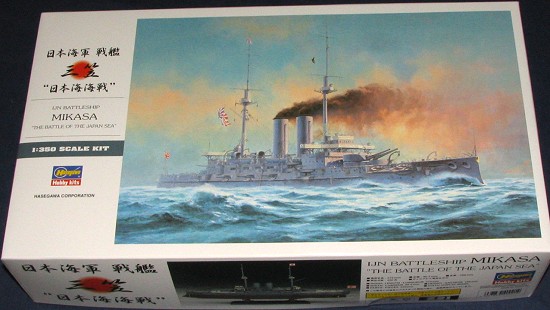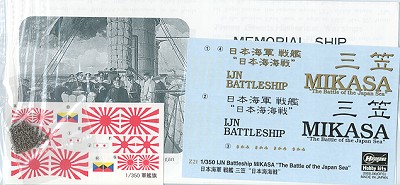
| KIT: | Hasegawa 1/350 IJN Battleship 'Mikasa' |
| KIT #: | 40021 (Z 21) |
| PRICE: | ¥ 6800 from Hobby Link Japan |
| DECALS: | One option |
| REVIEWER: | Scott Van Aken |
| NOTES: | Full Hull kit |

| HISTORY |
Following the 1894–1895 Sino-Japanese conflict, and the forced return of the Liaotung peninsula to China under Russian pressure, Japan began to build up its military strength in preparation for further confrontations. In particular, Japan promulgated a ten-year naval build-up program, with the construction of six battleships and six armored cruisers at its core.
One of these battleships, Mikasa, was ordered from the Vickers shipyard in the United Kingdom at the end of 1898, for delivery to Japan in 1902. She took three years to complete, at the great cost of £880,000 (8.8 million yen).
That same year Japan also secured diplomatic and strategic support, by concluding the 1902 Anglo-Japanese Alliance with the world's first naval power. The UK shared Japan's wish to contain Russian expansionism in the far east, especially to protect her Chinese interests.
At the time of her delivery, Mikasa was a state-of-the-art pre-dreadnought battleship, achieving an unprecedented combination of firepower and protective strength. She was adapted from the Royal Navy's latest Majestic class design, with increased displacement (15,140 tonnes against 14,900), improved speed (18 knots against 17), slightly stronger armament (two more 6-inch guns), and much stronger armour: she kept the same armour thicknesses but used high performance Krupp armour, around 50% stronger compared to the Harvey armour used by the Majestic class.
Her main guns, grouped in armoured turrets in a central position, allowed for the rest of the ship to be evenly protected with the heavy Krupp protective steel plates. Thanks to this design, Mikasa was able to withstand a large number of direct hits: she received around 20 hits during the battle of the Yellow Sea on 10 August 1904, and around 30 hits during the battle of Tsushima, with only limited damage. The firepower and the longer range of the guns of Mikasa were also fully exploited by highly trained and effective Japanese gunners.
At Tsushima, the Mikasa led the combined Japanese fleet into what has been called "the most decisive naval battle in history". The Russian fleet was almost completely anihilated: out of 38 Russian ships, 21 were sunk, 7 captured, 6 disarmed, 4,545 Russian servicemen died and 6,106 were taken prisoner. On the other hand, the Japanese only lost 116 men and 3 torpedo boats.
The performance of the Japanese fleet was observed and analysed by Western powers, and played an important role in the definition of the next generation of battleships (the Dreadnoughts), since the conflict "confirmed the greater efficiency of heavy guns and the importance of long-range gunfire." ("The Battleship Dreadnought" Conway Marine).
Also, the defeat of the Russian fleet and the signature of the Treaty of Portsmouth (signed September 5), intensified unrest in Russia. In 1905 there were naval mutinies at Sevastopol, Vladivostok and Kronstadt, peaking in June, with the mutiny aboard the Battleship Potemkin. The Russian Revolution of 1905 culminated in October, when the Tsar was compelled to renounce his absolutist powers, and sign the October Manifesto.
Finally, the Japanese victory confirmed Japan's emergence as the pre-eminent power in east Asia, and a force to be reckoned with on the international scene.
Now, Mikasa is the last remaining battleship of the pre-dreadnought era.
Ironically, after the peace treaty with Russia was signed on September 5, 1905, Mikasa suffered a fire while in harbour in south Japan, at Sasebo. A magazine exploded and she sank in 11 meters of water. She was later salvaged to continue service, but she soon became obsolete following the development of newer types of vessels, especially the Dreadnoughts.
Mikasa was decommissioned following the Washington Naval Treaty of 1921. In 1925, she was put on display in Yokosuka, Japan, as a memorial ship.
Following Japan's defeat in World War II, the American occupation forces confiscated Mikasa and dismantled her guns, leaving her in very poor state. By 1948 however, she was reverted to the mayor of Yokosuka. A preservation movement resumed in 1958, to which the US participated through financial support and the direct involvement of Admiral Chester Nimitz. The restoration was completed on May 27, 1961, at a cost of 180 million yen.
Mikasa has been designated as one of the "Three Great Historical Warships of the World", together with Victory in Portsmouth, UK, and Constitution in Boston, USA.
| THE KIT |
 As
soon as it was announced that this kit was going to be released, the 'floaty
types' were all a-buzz about it. If you have been paying attention to what
has been going on regarding ship modelers, it seems like the time between
around 1880 and 1930 are the current rage for those who like to do ocean
going ship models. There are also a large number of folks into US Civil War
ironclads as the contests I attend usually have quite a few of these on
display. However, almost all of these models are not main-stream kits but
resin or metal ones, put out by the short run folks. Only ICM, which
produced a pair of German Dreadnaughts a few years back have done anything
similar.
As
soon as it was announced that this kit was going to be released, the 'floaty
types' were all a-buzz about it. If you have been paying attention to what
has been going on regarding ship modelers, it seems like the time between
around 1880 and 1930 are the current rage for those who like to do ocean
going ship models. There are also a large number of folks into US Civil War
ironclads as the contests I attend usually have quite a few of these on
display. However, almost all of these models are not main-stream kits but
resin or metal ones, put out by the short run folks. Only ICM, which
produced a pair of German Dreadnaughts a few years back have done anything
similar.
As you have read above, the Mikasa was the last pre-dreadnaught battleship built and due to its historical significance to the Japanese, it is not surprising that this kit was produced. What many are wondering is why it took so long. From what I've been told, the first production run sold out very quickly and in with it was a special boxing that included a bust of Admiral Togo. It was also considerably more expensive.
This boxing includes a packet of 12 post cards of ships from this era. Probably those in Togo's battle fleet, but since all is in Japanese, I couldn't confirm that. A nice touch, though. There is also a brochure from the Mikasa today, a length of chain, a set of battle flags and a decal sheet for the ship and stand.
 The kit includes a lot of
sprues and is in three packages. The two sprues at the upper right of the
image are duplicated. As with the Trumpeter ship kits, there are a plethora
of ejector pin markings on the larger parts. Most will be hidden, but there
are those on the underside of overhanging decks that will be visible to the
flash-light crowd so be advised that they won't be easy to remove. There
are a few holes that need to be opened so I can see that there may be other
ships of this class in the near future. I've rarely known Hasegawa to
produce something new that doesn't have variant possibilities!
The kit includes a lot of
sprues and is in three packages. The two sprues at the upper right of the
image are duplicated. As with the Trumpeter ship kits, there are a plethora
of ejector pin markings on the larger parts. Most will be hidden, but there
are those on the underside of overhanging decks that will be visible to the
flash-light crowd so be advised that they won't be easy to remove. There
are a few holes that need to be opened so I can see that there may be other
ships of this class in the near future. I've rarely known Hasegawa to
produce something new that doesn't have variant possibilities!
Instructions are typical and quite well done. There are two full sheets, thanks to the complexity of this kit. Colors are from Gunze as one would expect. A full painting diagram is provided as well as a comprehensive rigging diagram. This last part is more complex that one would think, but you have to remember that masts and stacks were rigged and there were the necessary radio and signal flag lines that had to be incorporated.
| CONCLUSIONS |
There are a lot of happy campers out there thanks to this kit being released. Though this is the 'standard' boxing without some of the frills of the introductory kit, it should be a truly super model when done. I don't doubt that the aftermarket people are already working on additions, but from the look of things, the kit should be an outstanding build right from the box.
| REFERENCES |
Thanks to Wikipedia for the background info.
September 2005
My appreciation to Hobby Link Japan for providing the preview kit.
If you would like your product reviewed fairly and quickly by a site that has around 300,000 visitors a month, please contact me or see other details in the Note to Contributors.